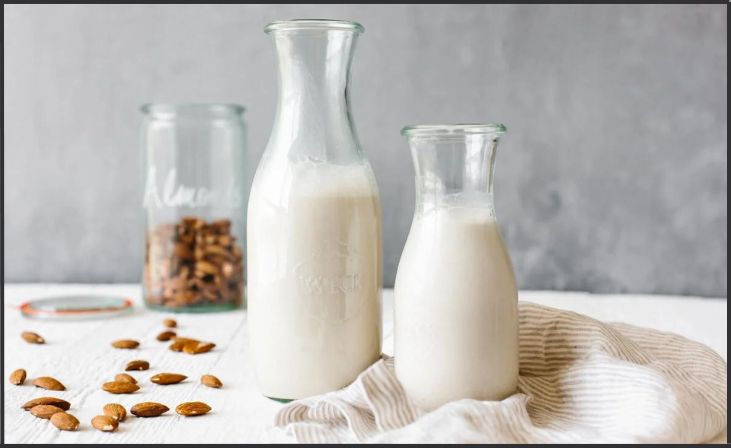Milk is a common ingredient in many pasta sauces, adding creaminess, richness, and flavor. However, if you are out of milk or looking for a dairy-free alternative, there are various substitutes that can be used in cooking and baking.
In this discussion, we will explore some options for milk substitutes in pasta sauces and provide tips for choosing and using them. We will also share some recipes and ideas for using milk substitutes in different pasta dishes.
By the end of this discussion, you should understand the different types of milk substitutes available and how to use them to create delicious and creamy pasta sauces.
Type of Milk Substitute For Pasta
Here are some common types of milk substitutes that can be used in pasta sauces:
Almond Milk

This is made from ground almonds and water and has a nutty flavor and a thin, watery consistency. It is a good source of vitamins and minerals, but it is low in protein compared to cow’s milk. Almond milk can work well in light, creamy pasta sauces but may not hold up well in heavier, thicker sauces.
Soy Milk
Soy Milk is made from soaked, ground soybeans and water and has a neutral flavor and a creamy consistency similar to cow’s milk. It is a good source of protein and is often fortified with vitamins and minerals. It has a slightly beany flavor and a creamy texture that can be similar to cow’s milk.
However, some people may be allergic to soy, which may not work well in sauces that require a lot of thickening, as it tends to thin out when heated.
Coconut Milk

This is made from the grated flesh of coconuts and has a rich, creamy texture and tropical flavor that can be a good substitute for heavy cream in some sauces. It is high in fat and can add a lot of richness to pasta sauces, but it may not be suitable for those who are lactose intolerant or looking for a low-fat alternative.
It can also be expensive and hard to find in some areas. Coconut milk can work well in tropical-themed pasta sauces, such as those made with seafood or curry spices.
Oat Milk
Oat Milk is made from oats and water and has a slightly sweet, nutty flavor and a creamy consistency similar to cow’s milk. It is a good source of fiber and can be used as a direct substitute for cow’s milk in most pasta sauces. However, it may not work well in sauces that require a lot of thickening, as it tends to thin out when heated.
When choosing a milk substitute for pasta, it’s important to consider the intended flavor and consistency of the sauce. However, it’s important to remember that they may have a different flavor, texture, or nutritional content than cow’s milk, and they may only work well in some pasta sauces.
How to Choose the Best Milk Substitute

When choosing a milk substitute for pasta, consider the following factors:
- Personal preference: Think about what you enjoy in terms of flavor, texture, and nutritional content. For example, if you prefer a nutty flavor, almond milk may be a good choice, while those who prefer a creamy, neutral flavor may prefer soy milk or oat milk.
- Dietary restrictions: Consider any dietary restrictions or allergies you may have. For example, those who are allergic to soy may want to avoid soy milk, while those who are vegan may want to choose plant-based milk.
- Flavor and consistency: Different milk substitutes have different flavors. Think about the intended flavor and consistency of the sauce. For example, coconut milk may not be the best choice for a light, creamy pasta sauce, but it can add a lot of richness to a heavier, thicker sauce.
To test and adjust the amount of milk substitute, start by using a small amount and gradually adding more until you achieve the desired consistency.
You may also want to adjust the amount of other ingredients, such as flour or butter, to help thicken or thin out the sauce as needed. It’s also a good idea to taste the sauce and adjust the seasoning as needed.
How do you choose the right milk substitute for a particular pasta dish?

There are a few factors to consider when choosing the right milk substitute for a particular pasta dish. Here are some tips to help you choose:
- Consider the flavor: Different milk substitutes have different flavors, so it’s important to choose one that will complement the other ingredients in the pasta dish. For example, almond milk may work well in a creamy pasta sauce, while coconut milk may be more suitable for a sweet pasta dish.
- Consider the thickness and creaminess: Some milk substitutes are thicker and creamier than others, which can affect the texture of the pasta dish. If you’re looking for a milk substitute that will give your pasta dish a creamy texture, you may want to choose one that is thicker and creamier, such as soy milk or coconut milk.
- Consider the nutritional content: Different milk substitutes have different nutritional profiles, so it’s important to choose one that meets your nutritional needs and preferences. For example, soy milk is a good source of protein, while oat milk is high in fiber.
- Consider any allergies or dietary restrictions: If you or someone you are cooking for has a milk allergy or lactose intolerance, it’s important to choose a milk substitute that is suitable for their needs. For example, almond milk is generally considered safe for those with lactose intolerance, while soy milk is a good choice for those with a milk allergy.
Ultimately, the best milk substitute for a particular pasta dish will depend on your own personal preferences and needs.
How does the flavor of different milk substitutes compare in pasta dishes?

The flavor of different milk substitutes can vary greatly in pasta dishes. Soy milk, almond milk, and oat milk tend to have a mild and neutral flavor, making them suitable for use in various pasta dishes.
Coconut milk has a distinct, sweet, and tropical flavor that may not be suitable for all pasta dishes but can work well in some Asian-inspired dishes or sweet pasta. Rice milk has a light and slightly sweet flavor but can also have a slightly grainy texture that may not be suitable for some pasta dishes.
It’s important to consider the flavor of the milk substitute when using it in pasta dishes, as it can affect the dish’s overall taste. Some milk substitutes may be more suitable for certain pasta dishes depending on their flavor profile.
Which milk substitutes have the highest nutritional content for use in pasta dishes?
The nutritional content of different milk substitutes can vary greatly. Soy milk is a good source of protein and is generally considered one of the most nutritionally complete plant-based milk alternatives. It is also a good source of essential vitamins and minerals, including vitamin D, calcium, and iron.
Almond milk is lower in protein and calories compared to soy milk, but is still a good source of essential vitamins and minerals, including vitamin E and calcium. Oat milk is also a good source of nutrients, including fiber, iron, and vitamin D.
Coconut milk is relatively low in nutrients compared to other milk substitutes, but is still a good source of healthy fats. Rice milk is also lower in nutrients compared to other milk substitutes, but is generally considered the most hypoallergenic option.
Can I Make Pasta Without Milk?
Yes, it is possible to make pasta without using milk. There are several alternatives that can be used to add creaminess and flavor to pasta sauces without using dairy products.
Some options include using plant-based milk, such as almond milk or soy milk, or using non-dairy creamers or yogurt. You can also use broth or stock, pureed vegetables, or tomato sauce to add moisture and flavor to your pasta dishes.
Here are a few ideas for making pasta without milk:
- Tomato sauce: Use a store-bought or homemade tomato sauce as the base for your pasta dish. Add vegetables, such as diced bell peppers or onions, and herbs or spices, such as oregano or basil, for flavor.
- Creamy tomato sauce: To make a creamy tomato sauce without milk, blend 1 can of diced tomatoes with 1/2 cup of broth or stock and 1/4 cup of soaked raw cashews until smooth. Heat the sauce in a pan over medium heat until hot, then season with salt and pepper to taste.
- Alfredo sauce: To make an Alfredo sauce using almond milk, heat a pan over medium heat and melt 2 tablespoons of butter. Add 2 cloves of minced garlic and cook for 1 minute. Stir in 2 tablespoons of all-purpose flour and cook for 1 minute more. Slowly pour 1 cup of unsweetened almond milk, constantly stirring to prevent lumps. Bring the sauce to a boil, then reduce the heat to low and simmer for 5 minutes or until thickened. Stir in 1/2 cup of grated Parmesan cheese and season with salt and pepper to taste.
- Carbonara sauce: To make a carbonara sauce using soy milk, mix 1 cup of soy milk and 2 egg yolks in a small bowl. Heat a pan over medium heat and cook 4 slices of bacon until crispy. Remove the bacon from the pan and set aside, reserving the bacon grease in the pan. Add 1/2 cup of soy milk to the pan and bring to a boil. Reduce the heat to low and stir in the egg yolk mixture. Cook for 1-2 minutes, or until the sauce thickens. Stir in 1/4 cup of grated Parmesan cheese and season with salt and pepper to taste. Crumble the bacon into the sauce and serve over pasta.
- Marinara sauce: To make a marinara sauce using coconut milk, heat a pan over medium heat and add 1 tablespoon of olive oil. Add 1 diced onion and 2 cloves of minced garlic and cook until the onion is translucent. Stir in 1 can of crushed tomatoes, 1/2 cup of coconut milk, and 1 teaspoon of dried basil. Bring the sauce to a boil, then reduce the heat to low and simmer for 10 minutes. Season with salt and pepper to taste and serve over pasta.
For variations, try adding different vegetables, such as mushrooms or bell peppers, to the sauces for added flavor and nutrition. To customize the sauces to your taste, you can also experiment with different herbs and spices, such as oregano or red pepper flakes.
How do milk substitutes affect the texture and taste of pasta dishes?

The texture and taste of pasta dishes can be affected by the type of milk substitute used. Some milk substitutes are thicker and creamier than others, which can affect the texture of the pasta dish.
For example, soy milk and coconut milk tend to be thicker and creamier than almond milk or oat milk, which may make the pasta dish more creamy and rich. On the other hand, thinner milk substitutes like almond milk or oat milk may result in a lighter, more broth-like texture.
The flavor of the milk substitute can also affect the taste of the pasta dish. Some milk substitutes, such as soy milk and almond milk, have a mild and neutral flavor that may not significantly alter the taste of the pasta dish.
Other milk substitutes, such as coconut milk, have a more distinct flavor that may alter the taste of the pasta dish. For example, coconut milk may add a sweet and tropical flavor to the pasta dish.
Conclusion
Milk substitutes can be a good option for those who are lactose intolerant or prefer plant-based alternatives in their pasta sauces. There are many types of milk substitutes available, including almond milk, soy milk, coconut milk, and oat milk, each with its own unique flavor, texture, and nutritional profile.
When choosing a milk substitute for pasta, it’s important to consider your personal preferences, dietary restrictions, and the intended flavor and consistency of the sauce. You can also experiment with different types of milk substitutes and flavorings to find the combination that works best for you.
We hope this discussion has given you some helpful ideas and inspiration for using milk substitutes in your pasta dishes.
Frequently Asked Questions
Milk substitutes offer a range of health benefits, catering to various dietary preferences. Choosing the healthiest option depends on individual nutritional needs.
While many milk substitutes work well in pasta dishes, selecting the best one depends on the flavor and texture you desire. Experiment with different options to find your perfect match.
Homemade milk substitutes allow for customization and freshness, often resulting in a delightful and personalized flavor that rivals or surpasses store-bought varieties.
Consider your dietary restrictions, taste preferences, and nutritional goals when selecting a milk substitute. It’s essential to find an option that aligns with your specific needs.

Leave a Reply